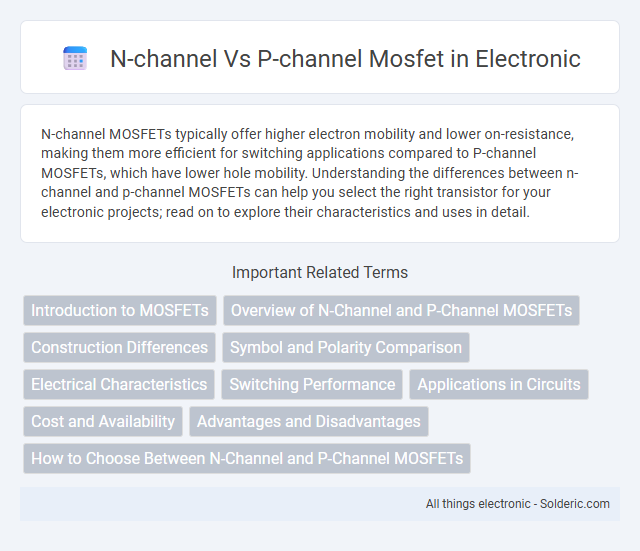N-channel MOSFETs typically offer higher electron mobility and lower on-resistance, making them more efficient for switching applications compared to P-channel MOSFETs, which have lower hole mobility. Understanding the differences between n-channel and p-channel MOSFETs can help you select the right transistor for your electronic projects; read on to explore their characteristics and uses in detail.
Comparison Table
| Feature | N-Channel MOSFET | P-Channel MOSFET |
|---|---|---|
| Carrier Type | Electrons | Holes |
| Conductivity | Higher (due to electron mobility) | Lower (due to hole mobility) |
| Threshold Voltage (Vth) | Positive | Negative |
| Switching Speed | Faster | Slower |
| Application | Low-side switching, power amplifiers | High-side switching, load switches |
| Voltage Polarity | Gate voltage higher than source to turn ON | Gate voltage lower than source to turn ON |
| Symbol | Arrow pointing out of source | Arrow pointing into source |
| Efficiency | Higher efficiency for switching | Less efficient than N-channel |
Introduction to MOSFETs
N-channel and P-channel MOSFETs are fundamental components in electronic circuits used for switching and amplification. N-channel MOSFETs conduct when a positive voltage is applied to the gate relative to the source, offering lower on-resistance and higher electron mobility compared to P-channel types. P-channel MOSFETs conduct with a negative gate-to-source voltage and are primarily used for high-side switching despite higher on-resistance due to lower hole mobility.
Overview of N-Channel and P-Channel MOSFETs
N-Channel MOSFETs utilize electrons as charge carriers, offering higher electron mobility and lower on-resistance, which results in faster switching speeds and better efficiency in power applications. P-Channel MOSFETs use holes as charge carriers and typically feature higher on-resistance and slower switching due to lower hole mobility, making them ideal for high-side switching in complementary circuits. Both MOSFET types are integral in designing efficient switching regulators, amplifiers, and digital logic circuits, where the choice depends on the specific electrical characteristics and layout requirements.
Construction Differences
N-channel MOSFETs feature an N-type conductive channel formed between two P-type regions on a P-type substrate, enabling electrons as majority carriers, while P-channel MOSFETs have a P-type channel between N-type regions on an N-type substrate, relying on holes as majority carriers. The difference in doping types and substrate material affects their electrical behavior, with N-channel devices generally exhibiting higher electron mobility and faster switching speeds. Understanding these construction differences helps you select the appropriate MOSFET for your circuit's performance requirements.
Symbol and Polarity Comparison
The symbol for an N-channel MOSFET features an arrow pointing outward from the source terminal, indicating electron flow, while the P-channel MOSFET symbol has an arrow pointing inward toward the source, representing hole flow. The polarity difference is evident as N-channel devices conduct when the gate is positively biased relative to the source, whereas P-channel devices conduct when the gate is negatively biased. Understanding these symbol and polarity distinctions helps you correctly identify and apply MOSFETs in electronic circuits.
Electrical Characteristics
N-channel MOSFETs exhibit lower ON-resistance and higher electron mobility, enabling faster switching and better efficiency in high-speed circuits compared to P-channel MOSFETs, which have higher ON-resistance due to lower hole mobility. The threshold voltage (Vth) for N-channel devices is typically positive, requiring a positive gate-to-source voltage to conduct, while P-channel MOSFETs have a negative threshold voltage, turning on with a negative gate-to-source voltage. Drain current capability and switching speed are generally superior in N-channel MOSFETs, making them preferable for power and switching applications.
Switching Performance
N-channel MOSFETs exhibit superior switching performance due to their higher electron mobility, resulting in faster switching speeds and lower on-resistance compared to P-channel MOSFETs. This characteristic leads to more efficient power conversion and reduced heat generation in applications like DC-DC converters and motor controllers. P-channel MOSFETs typically have slower switching times and higher on-resistance, which makes them less ideal for high-speed switching tasks.
Applications in Circuits
N-channel MOSFETs are preferred in high-speed switching applications and power management circuits due to their lower on-resistance and higher electron mobility, resulting in better efficiency and faster switching speeds. P-channel MOSFETs find common use in high-side switching applications and load switching in battery-powered devices because they simplify circuit design by allowing a common ground. Combining N-channel and P-channel MOSFETs in complementary push-pull configurations improves performance in analog circuits, such as class AB amplifiers and CMOS logic gates.
Cost and Availability
N-channel MOSFETs typically offer lower cost and greater availability due to their widespread use in power and switching applications, benefiting from higher electron mobility and efficiency. P-channel MOSFETs are less common, often resulting in higher prices and limited stock as they generally serve niche roles in complementary circuit configurations. Manufacturers prioritize production of n-channel devices, impacting overall market supply and pricing dynamics.
Advantages and Disadvantages
N-channel MOSFETs offer higher electron mobility, resulting in lower on-resistance and faster switching speeds compared to P-channel MOSFETs, making them more efficient for high-speed and high-current applications. P-channel MOSFETs simplify circuit design for high-side switching by allowing easier control with positive voltage signals but typically exhibit higher on-resistance and slower switching due to lower hole mobility. The trade-off between device efficiency and circuit simplicity dictates the choice, with N-channel favored for performance and P-channel preferred for convenience in certain configurations.
How to Choose Between N-Channel and P-Channel MOSFETs
Choosing between N-channel and P-channel MOSFETs depends on the required electrical characteristics and circuit configuration. N-channel MOSFETs offer lower on-resistance (R_DS(on)) and higher electron mobility, making them ideal for high-efficiency switching and low-voltage drop applications in the low-side switch role. P-channel MOSFETs are preferred in high-side switching due to simpler gate drive circuitry but typically exhibit higher R_DS(on) and lower performance compared to N-channel devices.
n-channel vs p-channel mosfet Infographic

 solderic.com
solderic.com